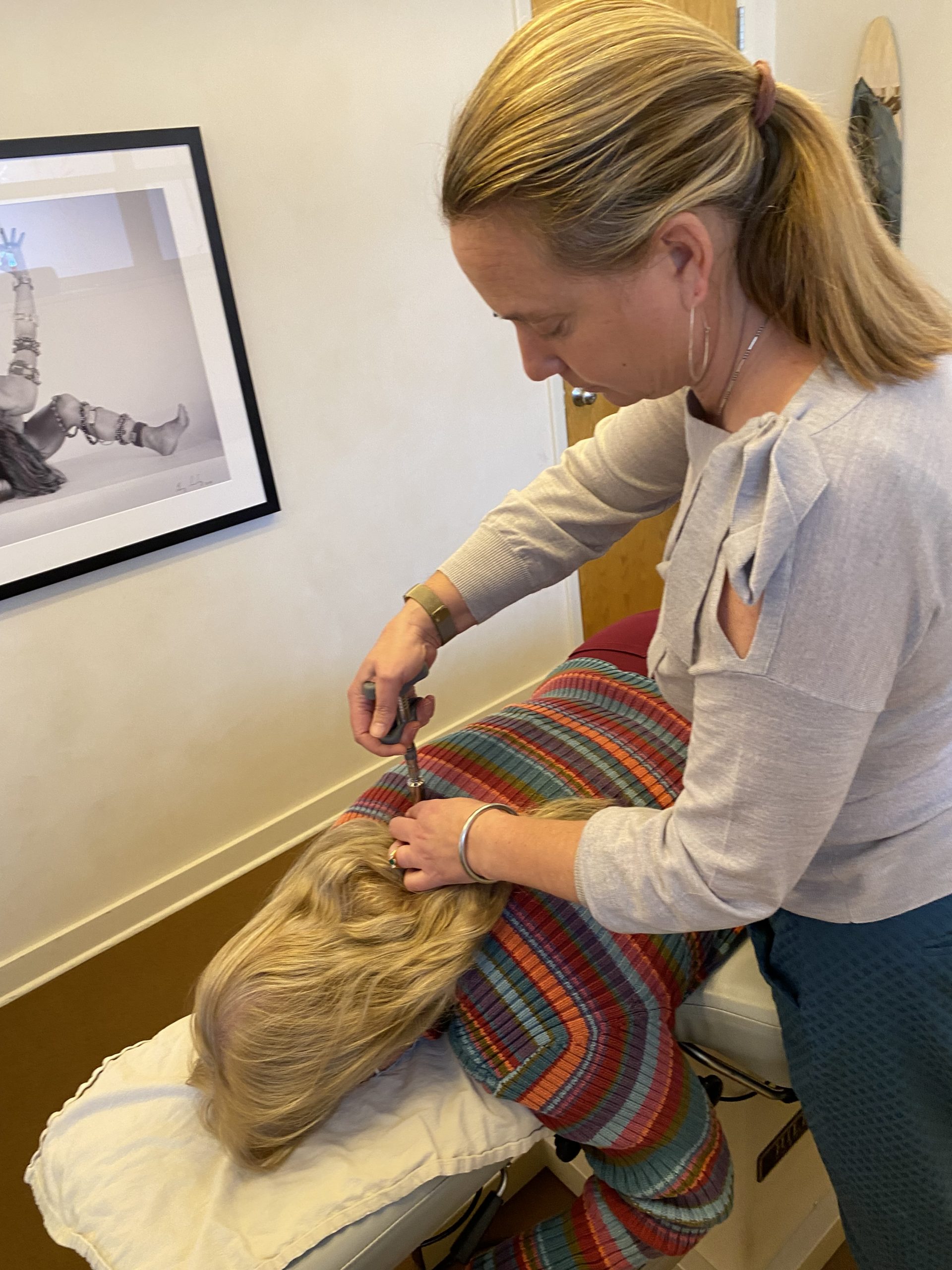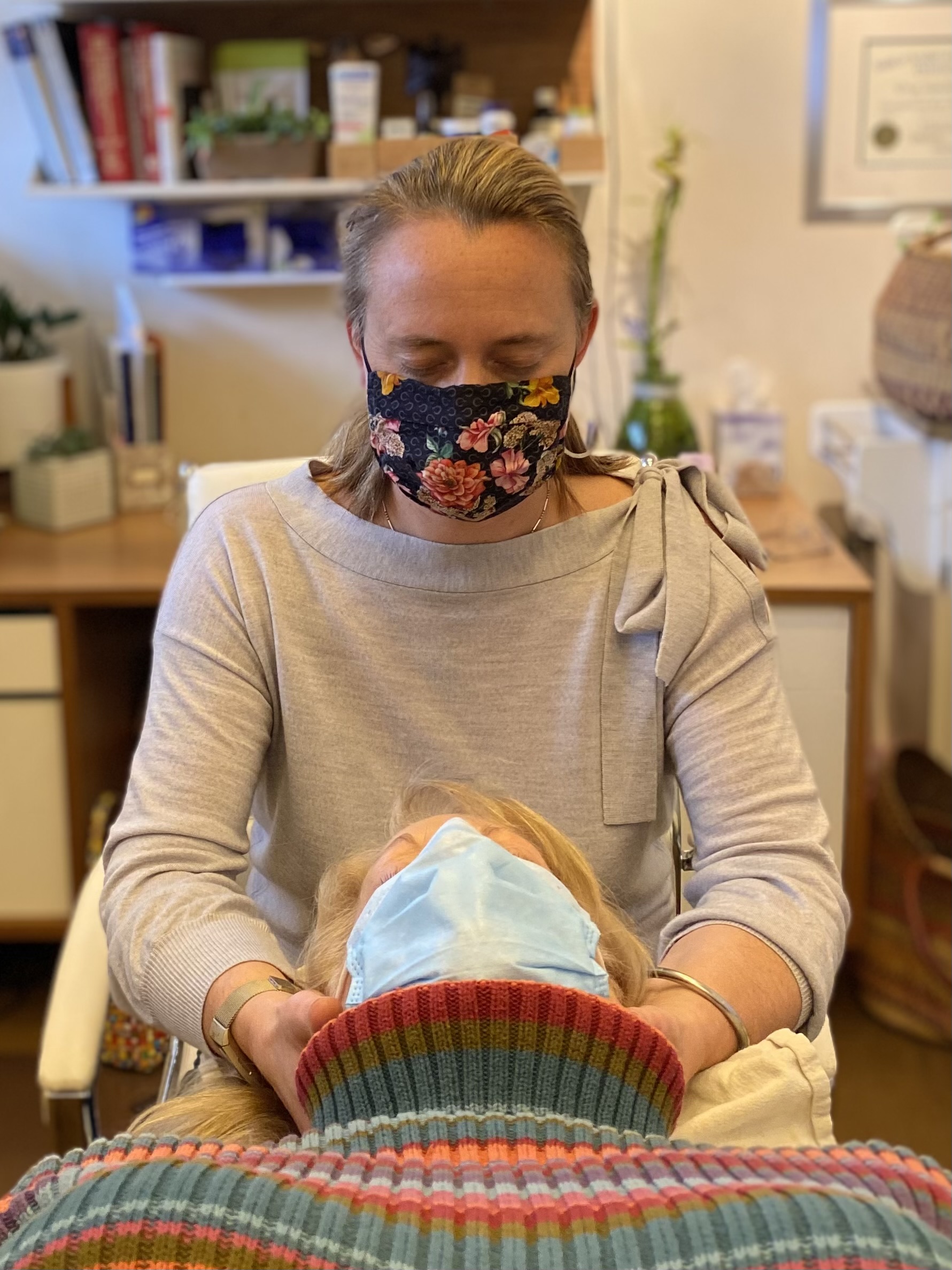My Services
Chiropractic Care
Craniosacral Therapy
Telehealth Sessions
Pediatric Services
Dry Needling
Dr. Arjan offers treatment options to fit all budgets and lifestyles.

Chiropractic Care
Dr. Khalsa offers a variety of chiropractic care services. At your first appointment, Dr. Khalsa will offer a consultation, followed by an exam, and finally an adjustment (if appropriate).
THE CONSULTATION
During the consultation, you can share the reason why you have come to see Dr. Khalsa. You will review your medical history, lifestyle, and health and wellness goals together. Consultations happen during your initial visit and helps Dr. Khalsa understand where you are in your health journey and whether or not she is able to help you.
THE EXAM
Based on the results of your consultation, Dr. Khalsa may proceed with a thorough examination of your spine and any extremities that are deemed necessary. The findings of the examination will inform her treatment guide.
THE ADJUSTMENT
If Dr. Khalsa feels that you are a good fit for treatment, she will end the first visit with a chiropractic adjustment and Craniosacral work.
Chiropractic adjustments are gentle and non-invasive and are used to reduce misalignments in the spine and other joints in the body. The goal of these adjustments is to improve function of the affected area, as well as reduce inflammation and improve the health of the nervous system. Learn more about Chiropractic
Craniosacral Therapy
CranioSacral Therapy (CST) is a gentle, hands-on approach that releases tensions deep in the body to relieve pain and dysfunction and improve whole-body health and performance. It was pioneered and developed by Osteopathic Physician John E. Upledger after years of clinical testing and research at Michigan State University where he served as professor of biomechanics.
Using a soft touch which is generally no greater than 5 grams (about the weight of a nickel), Dr. Khalsa releases restrictions in the soft tissues that surround your central nervous system. CST is increasingly used as a preventive health measure for its’ ability to bolster resistance to disease, and its effective for a wide range of medical problems associated with pain and dysfunction.
With a light touch, Dr. Khalsa uses her hands to evaluate the craniosacral system by gently feeling various locations of the body to test for the ease of motion and rhythm of the cerebrospinal fluid pulsing around the brain and spinal cord. Soft-touch techniques are then used to release restrictions in any tissues influencing the craniosacral system.
By normalizing the environment around the brain and spinal cord and enhancing the body’s ability to self-correct, CranioSacral Therapy is able to alleviate a wide variety of dysfunctions, from chronic pain and sports injuries to stroke and neurological impairment. Learn more about CranioSacral Therapy


Telehealth Sessions
Dr. Khalsa offers telehealth visits for patients who would like to see her, but are not located in New Mexico. Whether you’re experiencing specific symptoms that you’d like to address holistically or ready to take your health to a new level, you can schedule a one-time visit or a series of video calls. Dr. Khalsa meets you where you are currently and will help you develop a plan to meet your health goals.
What you’ll get in the initial visit:
- Video call visit
- Discussion of your history and how it may correlate with your current health challenges
- Dr. Khalsa’s assessment based on your history, current symptoms, medical records
- Discussion on how you want to proceed with your plan and set goals
- Plan for supplement and herbal protocol
- Links for ordering your supplements with Dr. Khalsa
- If needed, plan for which practitioners you can work with in your area
- Plan for any changes in your food and lifestyle
Pediatric Services
Dr. Arjan not only supports adults in their path toward healing, but also children of all ages. From birth through adolescence, the care that Dr. Arjan provides focuses on identifying the root cause of a child’s issue and working with the family to create a treatment plan that supports everyone.
Children can receive CranioSacral Therapy (CST) from Dr. Arjan as part of their treatment plan.
Craniosacral Therapy (or ‘CST’) looks pretty much like it does for adults, except it may look like Dr. Arjan is playing the game ‘Twister’ while she works with babies and young children. 🙂
She sits on the floor, walks with babies, or sits beside parent; whatever is most comfortable for the child.
Whether your child is feeding, asleep in the car seat, squiggling on the adjusting table or in your lap, she can get the work done to help alleviate the signs and symptoms that you’ve come in for treatment.
Nothing that Dr. Arjan does would be considered painful or harmful to your child. If you place your finger on your closed eyelid, that is the amount of pressure she will be using with your child. Most babies aren’t even aware that there is work being done

Dry Needling
Dry needling is a method utilized by Chiropractors and various healthcare specialists to address musculoskeletal discomfort and movement challenges. It’s commonly integrated into a comprehensive pain relief strategy, which might encompass Chiropractic adjustments, Craniosacral Therapy, exercise, stretching, manual therapy, among other modalities. During this procedure, Dr. Khalsa introduces fine needles (akin to Acupuncture needles) into the skin to target deep-seated myofascial trigger points.
The term “myofascial” combines “myo” denoting “muscle” and fascia, which is the delicate tissue encasing your muscles. Trigger points are tense, sensitive regions within muscles. These areas can be painful upon touch. A trigger point might be proximate to where you experience pain, but frequently, they’re the root of referred pain, which is pain perceived in a different body part.
Dr. Khalsa employs needles to mitigate these trigger points. The application of dry needling to muscles and tissues can diminish stiffness, boost blood circulation, and alleviate both localized and referred pain. The needles used are solid and devoid of medication, hence the term “dry” needling. Alternative designations for this technique include trigger point dry needling and intramuscular stimulation. Read More
Frequently Asked Questions — General Questions
How much will it cost?
Costs can vary, depending on your particular situation. Please visit the online scheduling page to see the different prices and options.
Dr. Khalsa spends an hour with every patient on their first visit. In this first visit, she will get to know you and your history so that she can best understand and determine where the root of your current health issues have come from. This is followed by Orthopedic and Neurological exams to determine if your health issues are something that she’s able to help you with. If she feels that she can help you, she will treat you on the first visit.
Depending on the severity of your symptoms and how long you’ve been experiencing them, she will discuss a treatment plan with you.
Dr. Khalsa tries to get you better as soon as possible so that you can get back to the life that you love. Sometimes this is 1-2 visits, and sometimes it takes months to achieve this goal.
You can expect anywhere from 2-6 visits upfront. She has packages available for you, if you pay for all 6 visits upfront.
How often will I need to come in?
After Dr. Khalsa assesses your situation, she will give you her opinion as to how often she feels is the most beneficial for you to get better fast.
How often will I need to return?
How long will my treatment take?
Sometimes one visit is all it takes, and sometimes it takes weeks or months of work. Every person is different, with their own set of life circumstances that may speed up or delay the healing process.
The length of your treatment depends on many factors, including: your age, the amount and severity of injuries you’ve incurred in your life, the levels of mental/emotional stress and the severity of your symptoms.
When will I start feeling better?
Each person is unique. Some people start noticing changes immediately during and after the treatment session. For others, they notice within a few minutes or a few hours. For some, they notice changes the next day and some may not notice changes for 3-4 sessions.
It takes time for your body to undo the malfunctions and that may take some work.
Our society has been trained to believe that taking a pill will solve the issue immediately because the pain is relieved. This may not be the case when you’re seeking alternative and holistic solutions. Healing takes time and to expect immediate relief isn’t always realistic.While Dr. Khalsa expects miracles, she also knows that it can take days, weeks, or months to fully recover.
Why doesn’t Dr. Khalsa take my insurance?
Dr. Khalsa provides care that goes beyond what insurance will cover. She adjusts your spine but she also provides muscle work and Craniosacral Therapy. When insurance is involved in the relationship between you and her, the insurance dictates what kind of care you are able to receive, which makes Dr. Khalsa’s job tricky. Dr. Khalsa wants the healing relationship to be between her and you without getting a third party involved. She wants to provide you with the highest quality of care possible.
Can Dr. Khalsa work with me if I’ve been in a car accident or if I’ve been injured at work?
Dr Khalsa is able to work with people who have been involved in injuries. And the sooner you come in for care, the better.
If you have insurance coverage through your auto insurance, or ‘Medpay’ the insurance company will pay Dr. Khalsa directly. If you have an attorney, Dr. Khalsa will contact him or her directly to see if she is able to work with them.
You also have the option of paying for your treatment at the time of service and she will provide you with a superbill that you can submit for reimbursement with your insurance company.
Can Dr. Khalsa work with my condition?
However, many people find relief through her work from: Headaches, neck,shoulder, upper, mid and lower back pain, anxiety, sports injuries, falls, wrist pain, joint pain, sinus issues.
Frequently Asked Questions — Chiropractic Care
Do chiropractic adjustments hurt?
Dr. Khalsa uses a very gentle style of Chiropractic. You are in charge of how you’d like to be treated, while you’re in her office. Because of the light touch and low-force methods she uses, there is no pain involved.
Occasionally, people experience a flare-up or what we call ‘a healing rebound effect’ a few hours following the first treatment or the next day. When this happens, it means that your body is readjusting and processing the adjustment. This is actually a move in a positive direction!
Additionally, Craniosacral Therapy is very gentle and non-invasive.
I’ve been to another Chiropractor before and he/she popped my neck. Why don’t you do that?
What is the Activator Method of adjusting?
The Activator is a hand-held instrument that provides a low-force, very specific method of adjusting. You will not hear or experience a ‘pop’ or ‘crack’ oftentimes experienced in more traditional adjustments.
This is a great technique that provides a gentle style of adjustment for all ages: babies to our wise elders. And still gets the job of decreasing pain and improving movement done.
What kind of education does a Chiropractor receive?
Chiropractors must complete college requirements in the basic sciences. This is followed by a 4 year program at an accredited Chiropractic College. Several national board exams must be passed, and in New Mexico, a state administered exam must be completed in order to practice Chiropractic.
Frequently Asked Questions — Craniosacral Therapy
What is Craniosacral Therapy?
CranioSacral Therapy (CST) is a gentle, hands-on approach that releases tensions deep in the body to relieve pain and dysfunction and improve whole-body health and performance.
Using a soft touch which is generally no greater than 5 grams (about the weight of a nickel) practitioners release restrictions in the soft tissues that surround the central nervous system. CST is increasingly used as a preventive health measure for its ability to bolster resistance to disease, and it’s effective for a wide range of medical problems associated with pain and dysfunction.
With a light touch, the CST practitioner uses his or her hands to evaluate the craniosacral system by gently feeling various locations of the body to test for the ease of motion and rhythm of the cerebrospinal fluid pulsing around the brain and spinal cord. Soft-touch techniques are then used to release restrictions in any tissues influencing the craniosacral system.
By normalizing the environment around the brain and spinal cord and enhancing the body’s ability to self-correct, CranioSacral Therapy is able to alleviate a wide variety of dysfunctions, from chronic pain and sports injuries to stroke and neurological impairment.
How does CranioSacral Therapy Work?
Few structures have as much influence over the body’s ability to function properly as the brain and spinal cord that make up the central nervous system. And, the central nervous system is heavily influenced by the craniosacral system – the membranes and fluid that surround, protect and nourish the brain and spinal cord.
Every day your body endures stresses and strains that it must work to compensate for. Unfortunately, these changes often cause body tissues to tighten and distort the craniosacral system. These distortions can then cause tension to form around the brain and spinal cord resulting in restrictions. This can create a barrier to the healthy performance of the central nervous system, and potentially every other system it interacts with.
Fortunately, such restrictions can be detected and corrected using simple methods of touch. With a light touch, the CST practitioner uses his or her hands to evaluate the craniosacral system by gently feeling various locations of the body to test for the ease of motion and rhythm of the cerebrospinal fluid pulsing around the brain and spinal cord. Soft-touch techniques are then used to release restrictions in any tissues influencing the craniosacral system.
By normalizing the environment around the brain and spinal cord and enhancing the body’s ability to self-correct, CranioSacral Therapy is able to alleviate a wide variety of dysfunctions, from chronic pain and sports injuries to stroke and neurological impairment.
What conditions does CranioSacral Therapy address?
- Migraines and Headaches
- Chronic Neck and Back Pain
- Stress and Tension-Related Disorders
- Motor-Coordination Impairments
- Infant and Childhood Disorders
- Brain and Spinal Cord Injuries
- Chronic Fatigue
- Fibromyalgia
- TMJ Syndrome
- Scoliosis
- Central Nervous System Disorders
- Learning Disabilities
- ADD/ADHD
- Post-Traumatic Stress Disorder
- Orthopedic Problems
- And Many Other Conditions
Is there any condition for which CST shouldn’t be used?
There are certain situations where application of CST would not be recommended. These include conditions where a variation and/or slight increase in intracranial pressure would cause instability. Acute aneurysm, cerebral hemorrhage or other preexisting severe bleeding disorders are examples of conditions that could be affected by small intracranial pressure changes.
How many CranioSacral Therapy sessions will I need?
Response to CST varies from individual to individual and condition to condition. Your response is uniquely your own and can’t be compared to anyone else’s — even those cases that may appear to be similar to your own. The number of sessions needed varies widely — from just one up to three or more a week over the course of several weeks.
When was CranioSacral Therapy developed?
It was in 1970, during a neck surgery in which he was assisting, that osteopathic physician John E. Upledger first observed the rhythmic movement of what would soon be identified as the craniosacral system. None of his colleagues nor any of the medical texts at the time could explain this discovery, however.
His curiosity piqued, Dr. Upledger began searching for the answer. He started with the research of Dr. William Sutherland, the father of cranial osteopathy. For some 20 years beginning in the early 1900s, Sutherland had explored the concept that the bones of the skull were structured to allow for movement. For decades after, this theory remained at odds with the beliefs of the scientific and medical communities. Dr. Upledger believed, however, that if Sutherland’s theory of cranial movement was in fact true, this would help explain, and make feasible, the existence of the rhythm he had encountered in surgery.
It was at this point that Dr. Upledger set out to scientifically confirm the existence of cranial bone motion. From 1975 to 1983 he served as clinical researcher and Professor of Biomechanics at Michigan State University, where he supervised a team of anatomists, physiologists, biophysicists and bioengineers in research and testing. The results not only confirmed Sutherland’s theory, but led to clarification of the mechanisms behind this motion — the craniosacral system. Dr. Upledger’s continued work in the field ultimately resulted in his development of CranioSacral Therapy.
What if I don’t notice anything during the treatment?
Don’t worry! It’s normal for most people not to ‘feel’ or notice much of what’s going on during a Craniosacral Therapy session. Because the work is so subtle, oftentimes, you may not notice the changes that are happening. That’s ok. The work does its job.
